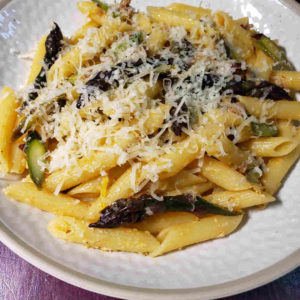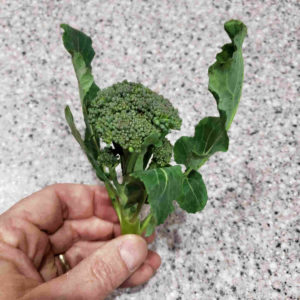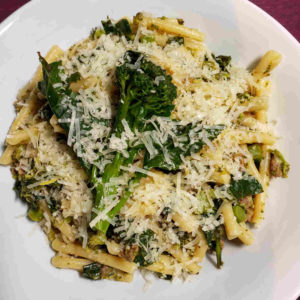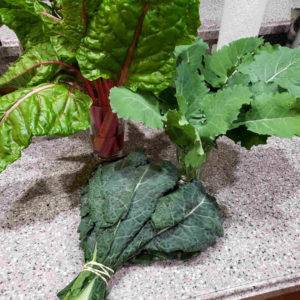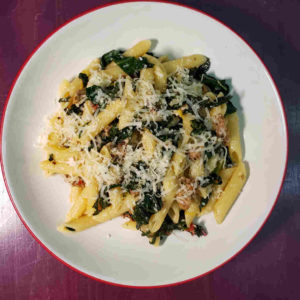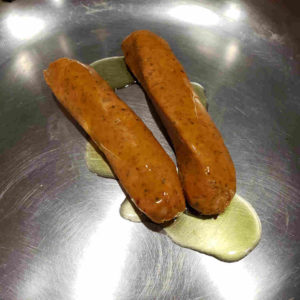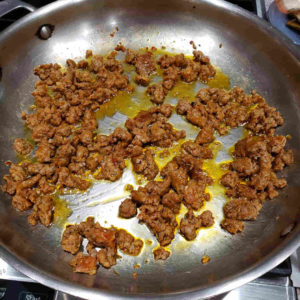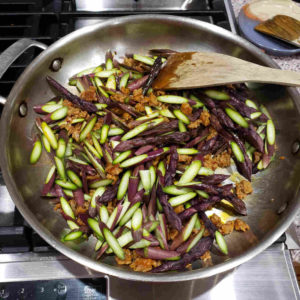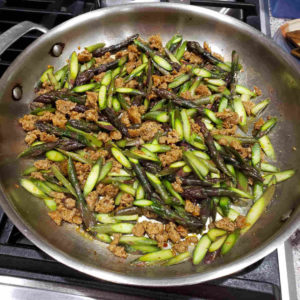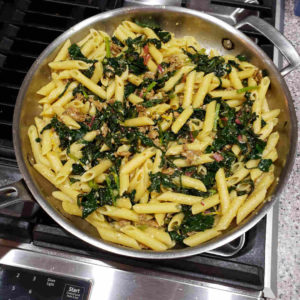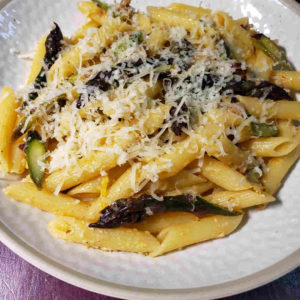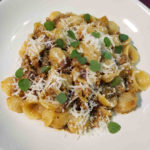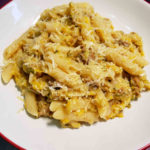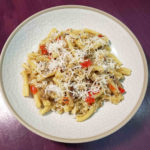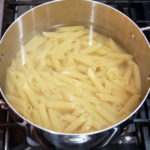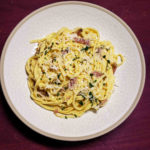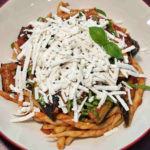This is almost a pantry recipe for me. I normally have lemons and hard cheeses in the fridge, spicy Italian sausage in the freezer and pasta on the shelf. So, it just takes one farm fresh vegetable to complete the inventory. The recipe is straight forward and comes together quickly, making it a great weeknight option. If you can multi-task, boiling the pasta at the same time as you sauté everything else, this will come together in 30 minutes. If you do things serially, it’s still only going to be around 45 minutes.
The Sausage
This recipe needs a really good Italian sausage. Its flavor should permeate the entire dish. My go to spicy Italian sausage is made by Firsthand Foods. Their products all come from local farms who humanely pasture raise their livestock, and they do a great job with processing and seasoning. If you aren’t in the Triangle area of NC, you will have to find a different source of great Italian sausage. It’s worth the effort to find a good one. Once you’ve found it, you can stick with it, and use it for so many different recipes.
The Asparagus
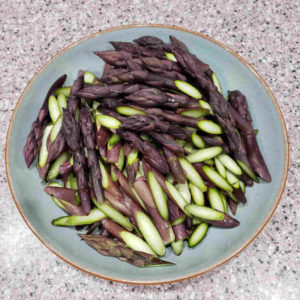
Here I have a gorgeous purple asparagus. Much of the purple pigment disappears with heat, but it’s still fun. To prep the asparagus, you certainly want to keep the tips intact. They are the highlight. For the stems, you can simply chop into 1 inch lengths for speed and simplicity. But, I like to cut them on a bias. This does a couple things. One, it looks really pretty. Two, it limits any stringiness that may be in the asparagus stems. The strings run the length of the stem, and cutting on a bias minimizes the length of the stem per piece. It does take longer to slice this way, but it’s also great knife skill practice.
Before moving on, I want to emphasize that the asparagus can be substituted. Broccolini, kale, raab, sugar snap peas, spigariello, and several other options will work in this dish.
The Cheese
For the cheese, I indicate an aged Asiago. The cheese that I prefer for this is Calvander from the Chapel Hill Creamery. They make it in the Asiago style, and age it for 8 months. This amount of aging is in a sweet spot for this dish. It’s quite hard, but still has a bit of meltability. You should feel free to substitute an aged cheese from a dairy near you. If you are sourcing from the standard grocery store, and the only Asiago they have is young and soft, I’d substitute a Pecorino Romano. Pecorino Romano is generally aged 5 or 6 months, and can be finely grated, but still has that bit of meltability. I have used Parmesan for this dish, and it works well enough, but something just a little more meltable is preferred.
The Sauce
The “sauce” produced for this dish is very light. I put “sauce” in quotes because it’s less of a sauce and more of a glaze. The pasta and asparagus should glisten with a wonderful tasting sheen. There won’t be any sauce pooling in the bowl. The sauce is made from olive oil, the fat and seasoning rendered from the Italian sausage, melted grated cheese, lemon juice, and a splash of starchy pasta water.
The Starchy Pasta Water
A splash (or more) of salty, starchy pasta water is an ingredient in many Italian pasta recipes. The starch acts as a thickening agent. The idea works really well in restaurant kitchens, where they continue to use the same pot of water through the course of the night. As they cook more dishes, the water gets more and more starchy. How do you get starchy pasta water at home, when you are making just a single batch of pasta in fresh water? The answer is to use less water. The method I’ve adopted comes from J. Kenji Lopez-Alt. The method only uses 2 quarts of water. Even more unorthodox, the majority of the cooking time is off-heat. He describes the testing and science behind the method here, and the actual process is incorporated into a recipe here. Don’t try this method for long pasta, unless you are willing to break it. I’ll describe the method in the recipe.
Pot and Pan Strategy
This dish generally takes a pot and a pan to complete. You’ll need a pot to cook the pasta, and you’ll need a pan to sauté everything else. If you have a sauté pan that is large enough to hold all of the ingredients, it is the most convenient option. You can prepare everything in that sauté pan, adding the cooked pasta to the pan when everything gets finished. This takes a 14” skillet, though. If you don’t have such a large pan, you can alternatively use the stock pot, after it has been drained, to do the final combination of the dish.
Other vegetable options
The recipe in pictures
Yes, a keen eye may pick out my photo error. I forgot to photo the pan after everything was brought together. I substituted a picture taken from the same recipe substituting a pound of mixed greens for the asparagus.
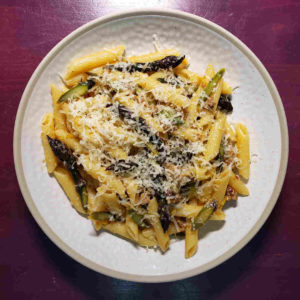
Pasta with Asparagus, Lemon and Sausage
Ingredients
- 1 lb asparagus (or broccolini, or kale, or…, ) stems chopped, with 3” tips intact
- 8 oz good Italian sausage casing removed
- 2 oz aged Asiago cheese finely grated, plus more for serving
- Zest of 1 lemon
- 2 oz freshly squeezed lemon juice
- 16 oz dried penne pasta (or other short pasta)
- olive oil
- salt and black pepper
Instructions
For the Sausage and Asparagus:
- Start by sautéing the Italian sausage in a tablespoon or two of olive oil over medium high heat. Using a pair of wooden spatulas, smoosh and break up the sausages into little bits. Sauté until the sausage is thoroughly cooked and starting to brown. Expect about 5 minutes.
- Add the asparagus with a pinch of salt and continue to sauté until the asparagus is cooked tender crisp. Expect about 5 minutes.
- Take the pan off heat until the pasta is ready (bonus points if you timed this so the pasta is ready just a minute or two after the asparagus is cooked).
For the Pasta:
- Read the suggested timing on the pasta packaging. This method should cook the pasta in about the same amount of time.
- In a small stock pot, bring 2 quarts of water and 1 Tbsp kosher salt to a boil over high heat.
- Add pasta and immediately stir vigorously.
- Allow to return to a boil, stir vigorously again, cover pot, and turn off the heat.
- After one minute, remove the cover and stir vigorously one last time. Re-cover pot.
- Let the pasta set until it is done. I find that this method tracks very closely to what is on the package directions, but you can check 2 minutes early and every minute after that until the pasta is ready. You are looking for that al dente texture where the pasta is softened, but still has bite to it.
- Scoop out one cup of the pasta water and drain the pasta.
Finishing the dish:
- Optimally, both the pasta and the asparagus and sausage will be hot when they are brought together. If you cooked the asparagus and sausage before the pasta, return them to the heat for the final two minutes of the pasta cooking.
- Bring the pasta, asparagus, and sausage together in a pan large enough to hold them, along with the lemon zest, lemon juice and the cheese. Also add a good 8 cranks from the pepper grinder. Stir everything vigorously. The heat in things should melt the cheese, which will be incorporated with the lemon juice and the water clinging to the pasta.
- Decide if you need to add a splash of the reserved pasta water. I often don’t, but it’s because I don’t let the pasta sit in the colander. I move the pasta to the final pan as quickly as possible and it’s still dripping a fair amount of pasta water. What you are looking for is just a glaze across the pasta. The best way to tell is to taste a single piece of pasta by itself. If it’s properly salted, lemony, savory, with a hint of aged cheese (i.e. if it tastes great all on its own), then you are done. If it needs a kick of salt, or seems entirely too dry, add a splash of pasta water and stir vigorously to work it in. Taste again. Repeat if necessary.
- Serve hot, garnishing with a bit more grated cheese.

